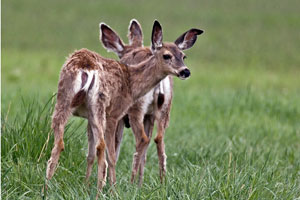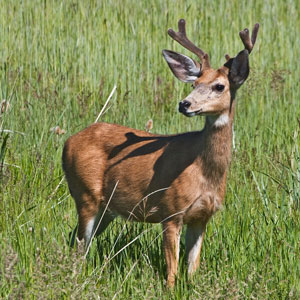

|
Mule Deer (Odocoileus hemionus) Mass 43 to 150 kg; avg. 96 kg (95 to 330 lbs; avg. 212 lbs)
Range / Habitat: Mule Deer are found throughout Washington, including the islands, in hardwood and coniferous forests, dense shrubs or other young successional stages with small trees or shrubs. They are also found in meadows, and grasslands, including alpine meadows, near forest. The availability of browse in forest understory is important for them.
Click the range map to learn more about the distribution of Mule deer in Washington. View a map of the distribution of White-tailed deer in Washington. Diet: Mule Deer are herbivores; they browse or graze depending on the season. They feed on a variety of vegetation including green plants, nuts and corn, and trees and twigs. They like to browse on Douglas fir and Ponderosa pine.
Behavior: The Mule Deer carries its thin, black-tipped tail drooped, unlike the uplifted, bushy white tail of its cousin. 
Mule Deer have large ears that move constantly and independently, from whence they get their name, "Mule" or "Burro Deer." They do not run as other deer, but have a peculiar and distinctive bounding leap (stotting) over distances up to 8 yards, with all 4 feet coming down together. In this fashion, they can reach a speed of 45 m.p.h. for short periods. (DesertUSA.com) Mule Deer are active primarily in mornings and evenings. Their inactivity during the heat of the day is a behavioral adaptation to the desert environment that conserves water and helps to regulate the body temperature. Reproduction: The Mule deer is a polygymous species, having a tending-bond type breeding system. Courtship and mating occur within the group. A dominant male tends an estrus female until mating or displacement by another male occurs. The breeding peak occurs mainly from late November through mid-December. The average gestation length is 204 days. The peak birth period is estimated to be from June 16th to July 6th, with most births occurring in June. (source: Animal Diversity Web)
Did you know?

Mule Deer photo More information: Mule Deer - Animal Diversity Web |
Animal silhouettes available to purchase »
Photos: Natures Pics
Home | About Us | How to Participate | Biodiversity Modules | Projects | Maps | News | Resources